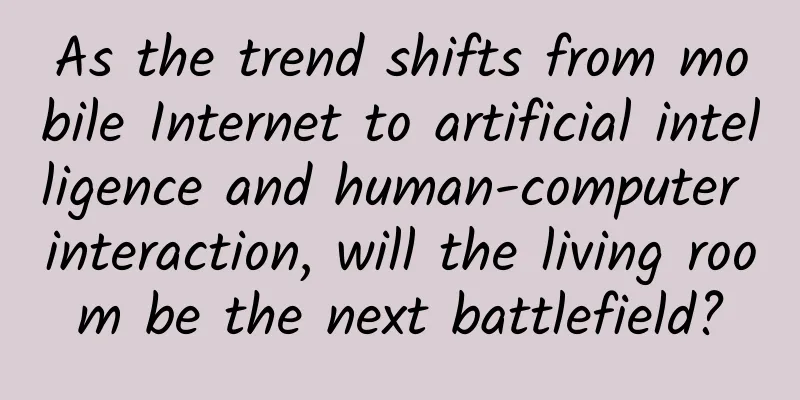As the trend shifts from mobile Internet to artificial intelligence and human-computer interaction, will the living room be the next battlefield?

|
2016 was not a smooth year for China's color TV industry. On the one hand, with the participation of Internet companies such as LeTV, Xiaomi, and PPTV, China's color TV industry was forced to usher in a wave of "price wars". On the other hand, with the rise in upstream costs, especially the cost of LCD panels, China's color TV industry has been forced to usher in another wave of price increases. Despite the ups and downs in prices, the retail sales of color TV industry in 2016 still broke through the 50 million units mark for the first time in history. According to data from Aowei Cloud Network, the retail sales volume of color TV in China in 2016 was 50.89 million units, a year-on-year increase of 7.8%; the retail sales volume was 156 billion yuan, a year-on-year decrease of 1.8%. However, even so, when compared with the retail sales volume of 46.74 million units and the retail sales volume of 157.2 billion yuan in 2015, it can be found that the color TV industry in China is in a vicious circle of "increasing production but not increasing revenue". The reason for this embarrassing situation is understandable. As the world's major TV producer and consumer, the domestic color TV market has been engaged in a price war in recent years due to the slowdown in market growth, which has led to some manufacturers being in a state of long-term negative profits. In this situation, some people even analyzed that 2015 will reach the peak of China's color TV industry. Moreover, the functions of traditional television in the past mainly include obtaining information, killing time, and family entertainment. The entertainment methods it can provide are relatively simple, and the main users are mostly women, children and the elderly. For young people, traditional television often does not have much appeal. When faced with more convenient products such as computers and mobile phones, they are more willing to choose these methods to pass the time and obtain news. However, the current situation where traditional television has difficulty gaining user attention may change. With the continuous development of science and technology, the new human-computer interaction method has finally come out of its long dormant period. In the past one or two years, with the rise of intelligent products, the way of interaction through voice has also ushered in explosive growth. The human-computer interaction technology, which has been developed for a long time, has also begun to truly enter the lives of ordinary people, and has entered an unprecedented stage of rapid development. For consumers, they currently pay more attention to finding meaning in products. Only by grasping users' pain points more accurately can they gain more favor. The future of interactive design lies in returning to human nature. Through designs that are more in line with daily life, it may bring new variables to smart TVs. Simple and unadorned design concept makes human-computer interaction a thing of the past Human-computer interaction originally refers to the technology that allows people and machines to communicate through some medium, and to exchange information under certain conditions. It not only improves work efficiency, but also promotes the rapid development of the technology industry again and again. Especially in the late 20th century, as the relationship between machines and humans became closer, the problem of human-computer interaction became more general. The interaction between humans and machines became the top priority of scientific research. During this period, the first thing that appeared was the typewriter, which further led to the emergence of the modern keyboard, which is a typical example in the history of human-computer interaction. The original typewriter keyboard was actually arranged in the order of ABCD. However, because the typewriters at that time were mechanical office machines, if the keyboard was struck too quickly, certain key combinations would easily cause key jamming problems. So the smart Americans invented the familiar QWERTY layout keyboard, and this layout was also inherited in the development of human-computer interaction in the future, and eventually gradually formed the keyboards seen on the market today. However, if you want to significantly improve work efficiency, it is far from enough to rely on the keyboard alone. With the development of the times, the information that humans need to process is no longer as simple as text. Therefore, people urgently need a more intuitive and convenient way of interaction. This is the reason for the emergence of the mouse. The emergence of the mouse made people feel the charm of free interaction for the first time. Users can click anywhere on the screen at will, and at the same time, the scope of application of the machine is broadened in complex data processing. Although keyboards and mice do not look as high-end as the later "voice" and "touch" methods, the natural, human, simple and emotional qualities displayed in their design core are indeed worth learning from. On the one hand, with the development of human-computer interaction technology, it has promoted the emergence and development of a series of emerging industries. On the other hand, every progress in human-computer interaction has indeed changed the way humans operate machines. Graphical interface changes user experience Communication between humans is so common and smooth, but machines are still unable to achieve a more natural way of communication, and are constantly struggling with the two completely different methods of digital and analog in the process of human-computer interaction. Operating systems have faced tremendous changes since the middle of the last century, because at that time the performance of the machine was not an obstacle to public acceptance and recognition. Even when large computers with super-superior performance were invented, they were abandoned because almost no one knew how to use them. However, the breakthrough in the operating system is definitely not as simple as just making changes to the hardware. Judging from the development trend of science and technology, since the 1970s, if there is a technology that can create a new era, it is undoubtedly the graphical user interface, the greatest concept and product in the history of human-computer interaction design. The world's first graphical user interface came from Xerox PARC, which developed the first personal computer using the Alto operating system. Alto was the first to integrate all the elements into a modern graphical user interface. It was quite small, but had a powerful ability to process image information and share information. It had a "what you see is what you get" document editor and a large number of fonts and text formats built in. In addition, Xerox PARC also developed a programming language and environment called Smalltalk, which had its own GUI environment. It can be said that Xerox PARC visualized those abstract tools in computers into graphical interfaces that even children can understand and master. On the one hand, the emergence of graphical interfaces not only changed the traditional way of human-computer interaction, but also pushed information technology to the forefront. On the other hand, because of this new way of human-computer interaction, the concepts that were supposed to be abstract before have now become an inseparable part of our modern life, and today's highly developed graphical interfaces really blur the boundaries between the virtual and real worlds. Human-computer interaction helps personalized TV experience and promotes industry development Although human-computer interaction does not essentially promote product changes, it actually expands the ways in which these products are used. With the change of the usage environment, it not only expands the possibilities of products, but also pushes these products to new heights. Just when smart TVs are in trouble with both "large screen" and "content war", TV manufacturers seem to have discovered that they can make some changes to the operation method. The old way of controlling traditional TVs by using remote controls is no longer suitable for today's social needs. With the help of the human-computer interaction system of smart TV, it is possible to extract the latest and hottest video content on the entire Internet based on user behavior, social hot spots, personal settings and other factors, and intelligently recommend and push the most suitable videos. Through intelligent algorithms, it is possible to create personalized experiences for thousands of people. Not only that, as the concept of smart homes is gradually implemented, smart products such as mobile phones, tablets, wearables, smart homes, and smart cars continue to emerge. At the same time, various services, software, and applications are also rapidly popularizing, and more and more applications are beginning to introduce human-computer interaction systems. On the one hand, the technical level of human-computer interaction has been continuously improved, especially with the rapid development of speech synthesis and basic speech recognition technology. On the other hand, the business scale has continued to expand, which has not only driven the rapid development of smart products such as home appliances and mobile phones, but also the related industries of smart cars. A large number of excellent companies have emerged, such as industry pioneers such as Nuance, Google, iFlytek, and Jietong Huasheng. Human-computer interaction will bring users more targeted choices in terms of content, and is completely different from the traditional way of constantly using the remote control to operate in order to find the program you like on TV. It not only stands firm on the foundation of "people-oriented", but also realizes the interaction and connection between products, achieving the goal of truly liberating manpower. New ways of interaction are coming With the continuous penetration of Internet thinking, the integration trend of traditional home appliance industry is becoming increasingly obvious, and the boundaries between products are becoming increasingly blurred. Coupled with the increasing maturity of technologies such as the connection capabilities of various terminals in the home and data synchronization, the era of smart home is no longer just a concept. At the same time, smart TVs, which have grasped the pain points of users, have naturally become the "core" of the entire smart home appliance with their rich resources and high compatibility. As smart TVs become the core of the entire smart home appliance, human-computer interaction methods are becoming more and more diverse. In addition to traditional TV remote controls, voice control, gesture operation, face recognition, touch control and other interaction methods have been applied to smart TVs to varying degrees, and various technologies are constantly developing and becoming increasingly mature. Among them, voice control function is currently a relatively mature part of the human-computer interaction mode of smart TV. Mainstream smart TVs are equipped with voice control and voice input functions. iFlytek, a leading company in voice input technology, has already established cooperative relations with mainstream smart TV manufacturers in China, and its voice input recognition is already quite high. In addition to voice input, the application scope of voice control of current smart TV products is constantly expanding, and comprehensive voice control of TV is gradually realized. The competition among different brands of smart TVs with their own unique features is actually more about the competition in user experience. The TV companies that stand out in the later stage must be those with unique service content that can provide consumers with a better experience. Therefore, the emergence of human-computer interaction not only changes the existing user operation mode, but also makes it easier for users to see their favorite content through intelligent push based on human-computer interaction, saving time and cost, and avoiding the frustration of being at a loss in massive film and television resources. Although it cannot replace a variety of applications, it will eventually be integrated into our lives and bring us a new lifestyle, a lifestyle where everything can be simple. Human-computer interaction empowers television Just as smart TVs are developing in a more intelligent direction, weak hardware levels have become a stumbling block on the road to progress. On the one hand, there is a lack of a powerful chip, and on the other hand, there is a lack of independently operated cloud platforms and big data operations. Not to mention, there are no fun applications on mobile devices such as smartphones and tablets, which has resulted in smart TVs never becoming smart. The bottom line is that smart TVs are too backward at the "chip" level. For a long time, the "TV chips" used in smart TVs have lagged behind "mobile chips" in performance. The simplest example is that "the processing speed required for large games that can run smoothly on smartphones is simply not achieved by smart TV chips." However, as human-computer interaction has begun to be invested in the TV market on a large scale, in order to enable smart TVs and other smart devices to perfectly achieve multi-screen interaction and multi-screen collaboration without lag, the chips of smart TVs have been upgraded, making the connection between TVs and mobile devices and mobile applications closer, and even seamless docking is no longer a dream. At the same time, with the further application of human-computer interaction on TV, smart TV will be significantly different from other smart home appliances. In the past, smart home appliances were more symbolic in their "intelligence", that is, they were operated through large screens and APPs, which not only failed to improve the quality of life, but also failed to fundamentally liberate manpower. However, smart TV can push intelligence to a new level through human-computer interaction. With the advancement of technology, the emergence of various sensors has begun to bring human-computer interaction on smart TVs into a new stage. That is, the machine can actively "understand" the user's intention. Although this understanding is still very simple at present, it may be as simple as automatically selecting a screen or automatically pushing a program. But this is an essential change in human-computer interaction. The interaction between people and machines is no longer a simple "you say, I listen". Perhaps it is the large-scale promotion of human-computer interaction in the smart TV industry today that has given smart TVs a broader space for development. With the continuous upgrading of technology, not only has the position of smart TV as the core of smart homes been solidified, but people's lifestyles have also begun to slowly change. Smart TVs will provide big data for artificial intelligence It is generally accepted that artificial intelligence will be the core of smart life. However, in fact, the artificial intelligence products based on smart life have not received much attention in China. As of January 2017, Echo's voice intelligence Alxea has mastered more than 7,000 skills, which means that behind Alxea, there are a considerable number of finished products that can be directly connected to Echo, greatly improving the product's usage environment. Although Google Home has a lower degree of compatibility and cannot get rid of its dependence on its own products, Google Home integrates Google's latest assistant function, which is similar to Apple's Siri. It is not just a simple voice command system, but has added certain artificial intelligence and neural network features. It can not only understand what the user is saying, but also enable interactive conversations. Relatively speaking, Amazon's Alexa will only enable dialogue within a certain set value and will not respond to content it cannot understand. Even so, although it is difficult for both products to shine in the Chinese market at present, it is still a feasible development direction for the smart home appliance platform, which is to integrate the control of the entire smart home appliance product into one product. Therefore, smart TVs have become the best candidates for the core hub of smart home appliances due to their "large screen" and "intelligent" features. On the other hand, through the continuous upgrading of human-computer interaction technology, smart TVs will adapt to more and more life scenarios, and by analyzing these scenarios, a series of important data will be obtained for application in artificial intelligence technology. In the future, artificial intelligence, which has become the focus, will make a qualitative leap with the help of big data. Behind the rapid development of artificial intelligence, smart home appliances, led by smart TVs, will build a complete set of smart life solutions with advanced human-computer interaction technology. As a winner of Toutiao's Qingyun Plan and Baijiahao's Bai+ Plan, the 2019 Baidu Digital Author of the Year, the Baijiahao's Most Popular Author in the Technology Field, the 2019 Sogou Technology and Culture Author, and the 2021 Baijiahao Quarterly Influential Creator, he has won many awards, including the 2013 Sohu Best Industry Media Person, the 2015 China New Media Entrepreneurship Competition Beijing Third Place, the 2015 Guangmang Experience Award, the 2015 China New Media Entrepreneurship Competition Finals Third Place, and the 2018 Baidu Dynamic Annual Powerful Celebrity. |
>>: Who is responsible if a vehicle slides downhill in snowy weather and causes death?
Recommend
Osmanthus flowers in Zhejiang bloomed in March? Experts: They may have been "tricked" by the temperature
In March, some netizens discovered that osmanthus...
Hiss! Burned by the hot pack again? We did an experiment to reveal the truth about the burns caused by the hot pack!
Every winter, we always see a lot of news about p...
Big money sponsors are all producing their own original content. Has the era of “enterprise as media” arrived?
On February 6 this year, Starbucks launched a spe...
Albert: Learn English without taking detours
Albert: Learn English without taking detours Reso...
Today is the end of the dog days. All four seasons are pleasant, but the best is the new autumn.
There is no heat through the east window at night...
10 basic skills necessary for operating Douyin
Douyin became a huge hit like a bolt from the blu...
Securities Times: Speculating on the stocks of companies like LeEco is tantamount to condoning crimes
In the past five trading days, LeTV's stock p...
WeChat Mini Program "Decompile" Practice (I): Unpacking
This practical tutorial will tell you step by ste...
Lichuan SEO Training: Why do search engine marketing? Which is the largest search engine?
Many people use search engines when they surf the...
Can’t come up with notes for popular articles on Xiaohongshu? 5000-word complete guide!
"Hey, my notes have had poor traffic recentl...
Is it expensive to develop a Jincheng daily necessities mini program? Jincheng daily necessities mini program development costs at a glance
The main factors affecting the price of mini prog...
The chemistry teacher is a role model during the day and becomes the webmaster of a porn website at night
Zhao, 35 years old this year, is a chemistry teach...
Talk about the three core weapons of WeChat official accounts to incubate communities
This week, in a community I joined that was incub...
Apple’s May App Store promotion summary report: Cleaning up tens of thousands of abandoned apps!
In May, Apple once again cleaned up a large numbe...
The promotion effect is not good, maybe you didn’t think it through at the beginning
Whether it is user operation , product operation ...









